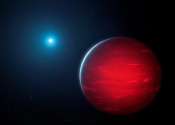Citizen scientist leads discovery of 34 ultracool dwarf binaries using data archive
A citizen scientist has searched NSF's NOIRLab's catalog of 4 billion celestial objects, known as NOIRLab Source Catalog DR2, to reveal brown dwarfs with companions. His intensive investigation led to the discovery of 34 ...









